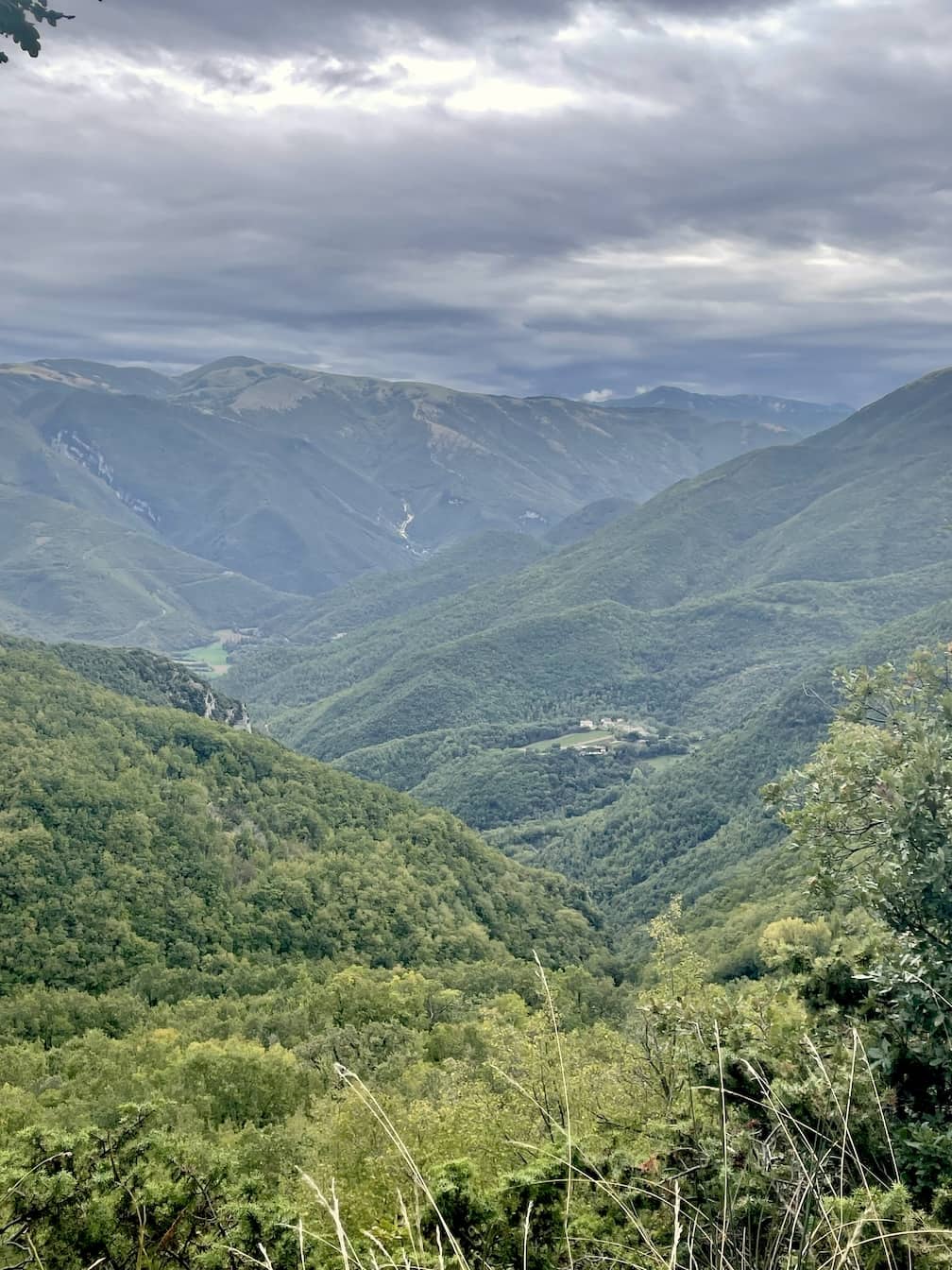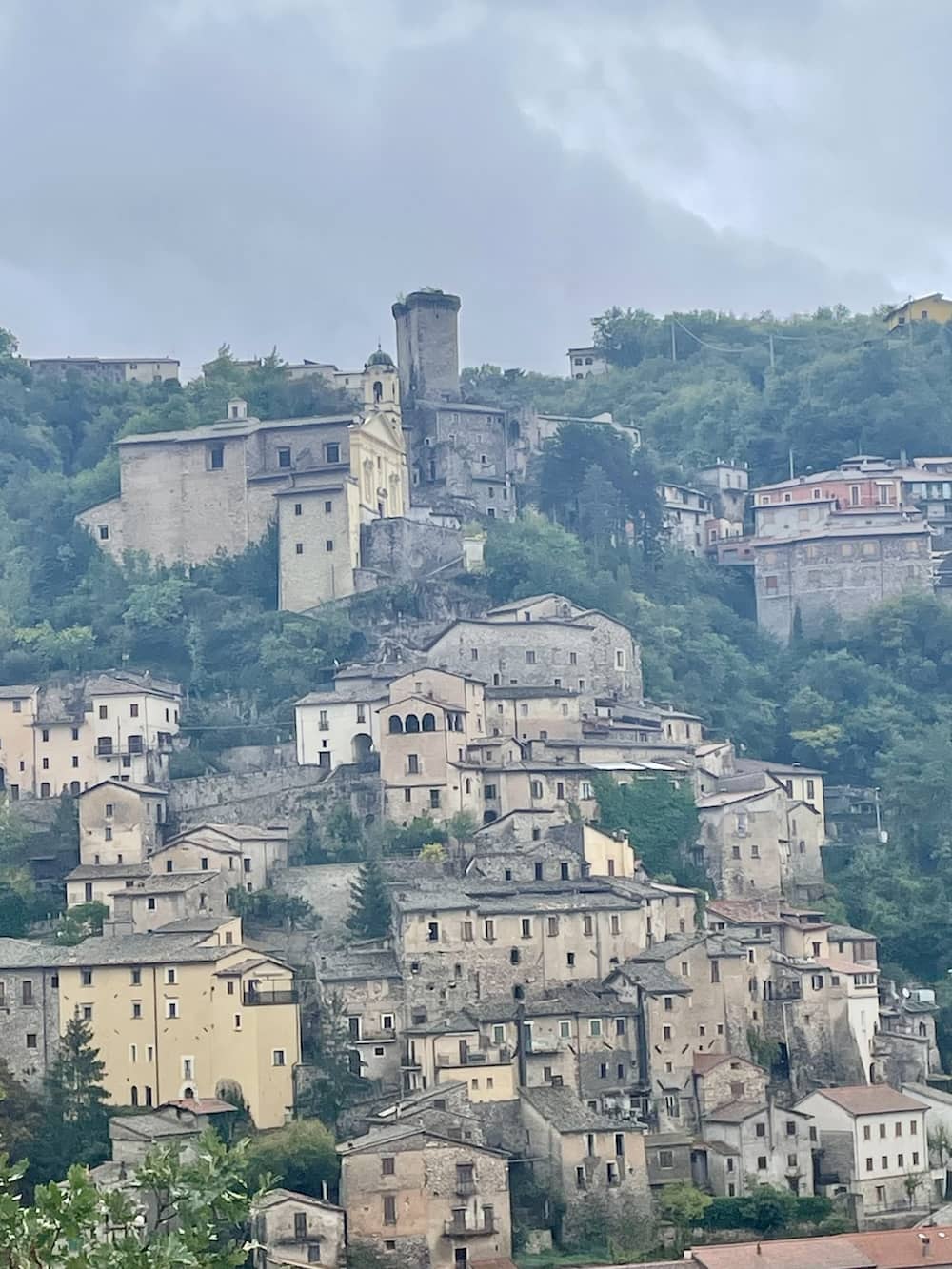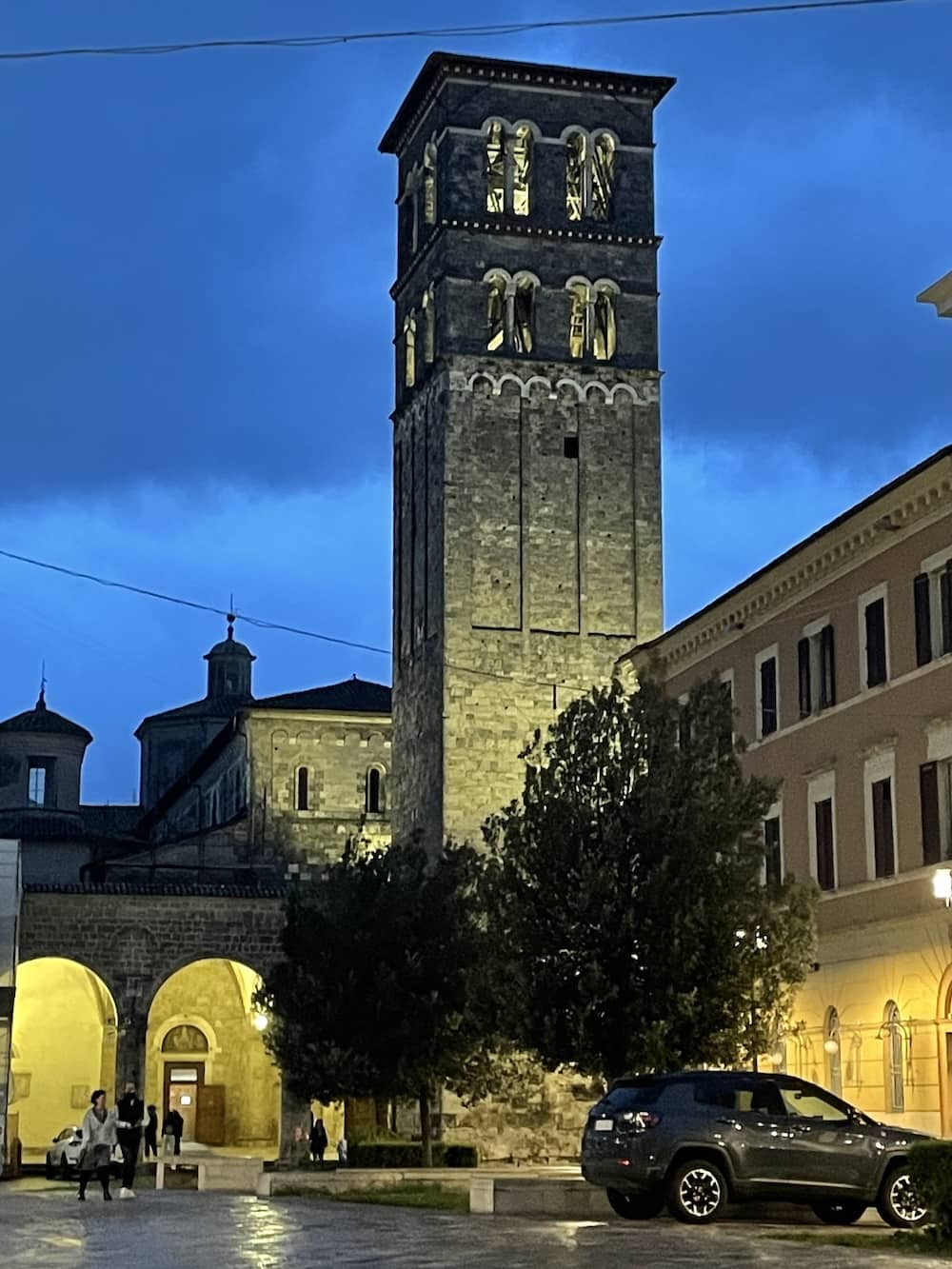The Via di Francesco or St Francis Way starts in Florence then continues on to Rome via Assisi. This route is 550 km and takes 28 days of walking. In October 2023, Martin, Bruce and I walked the southern section from Assisi and stopping at Rieti.

Bellissimo – what more can one say. The walk bounced up and down the Apennines along the centre of Italy through many little villages and towns, each as pretty as the next. Our accommodation ranged from hotels in larger towns to basic agriturisimo (farm stays) in the more remote areas. The food – well there was lots of it and it was excellent. The breakfasts, especially at the smaller stays, were more rudimentary and even in the larger hotels the idea of sweets at breakfast was a new experience.

Our usual walking day routine was to have breakfast as soon as it was available then head off and aim to arrive at our lodgings by about 3:30 in the afternoon, do our washing and whatever other tasks needed doing, then meet at 4:00 and find somewhere for an aperitivo. An Aperol spritz at 4:30 was a nice pick me up, while Martin and Bruce enjoyed either a spritz or wine aperitivo. We would then have a wander around the town until it was time for our evening meal at 7:30.
The days walking ranged from as little as 12 km to usually in the low 20s km per day, this being dependent on where the accommodation was located and how many hills were to be traversed.

Assisi is a magnificent medieval town with so many beautiful basilicas, churches, and Roman and medieval ruins – it exudes history at every turn. Prior to leaving Assisi we visited the pilgrim’s office at the Basilica of Saint Francis to have our Credenziale del pellegrino stamped to document our journey.
Departing Assisi, we hiked out past the Rocca Maggiore – a medieval fortress and then on to climb Mount Subiaso. The first way marker after leaving the town was a bit of a hit or miss situation and we very nearly missed it. The climb was steep and the path a little narrow and close to the edge in parts, but the views back towards Assisi were magnificent [this is the magazine cover image].
On the whole the Via is generally well sign posted with a variety of differing emblems and coloured paint splotches (colours and symbols varying depending on the area you were traversing).

After passing many of the monasteries visited by Saint Francis, we descended into the valley to our next stop at Spello. We partook of a drink of water from a Roman fountain, fed by the still functioning Acquedotto Romano di Spello. Another beautiful evening with the sunset seen between the ancient houses from a bar in the town. The accommodation here was in an Albergo in the medieval area of the town.

Next we went on to Colle San Lorenzo, near Foligno, walking through the olive groves along the way. There we stayed in an agriturismo out of the township. A magnificent 4 course meal was laid on there that evening.
The walking trails ranged from road walking both dirt and bitumen, forest trails, olive groves, fields and vineyards. I was amazed how many dirt roads there were that carried traffic when outside the larger cities.

The next day we encountered some steep climbs, forests and more olive groves on our way to Bovaro di Trevi. Passing through Trevi, a beautiful town on the hill, we did a little sight seeing before heading on to Bovaro and our next Agriturismo stay. The next day was another day of hill climbs through heavily wooded mountains on our way to Poreta.

At this stage we were walking with a group of Dutch “pilgrims” who we had met at Colle San Lorenzo. On these types of walks you do meet different people and may walk with them for a day or two, then part ways to perhaps meet again later on the trail. The accommodation in Poreta had taken a large leap forward; we stayed at the Borgo della Marmotta Farm Resort which was very nice indeed and a lovely soak in the large bath was in order after a hard day’s walking.

The following day we headed for Spoleto – a third day of climbing up and down numerous hills in the Apennines. Spoleto is a larger town and we had a rest day here to do some sight-seeing. There is, naturally – the Duomo, and La Rocca and also the Ponte delle Torri bridge / aqueduct, and a very excellent travelator system that runs underground from the base of the town up to La Rocca.

We parted ways with out Dutch friends at this point. The Via is supposed to leave Spoleto by crossing over the Ponte, but this has been closed for several years now for maintenance. The detour adds several kilometres onto an already hard day and when we rose the next morning the rain was pelting down, so we taxied up to Monteluco, a Franciscan convent, in the forest on the hill and avoided the slipping and sliding that would have eventuated had we decided to climb to the 932m top.

The rest of the day was downhill back into the valley and on to Ceselli. On the way we passed by the abandoned alternative type settlement of Sensati which had numerous interesting objects and paintings displayed.
We overnighted in Ceselli in another agriturisomo with a very lovely little restaurant in the building basement. It seemed like most of the village was eating there that evening. As the breakfast was again rudimentary, we ordered a takeaway pizza and had that for breakfast the next morning.

The next two days were valley walking. Every other hill we passed seems to have a village set atop it – so pretty an area with the River Nera running along side the path a lot of the way. We passed through Ferentillo where I went and checked out the Mummy Museum in the crypt below the church, while Martin and Bruce sat in the piazza eating lunch.
We headed on through the Parco Fluviale del Nera towards Arrone, this time we went through the old town, and out over a highway to a little motel on the outskirts of town. Up to now our accommodation had usually been located in the medieval areas of the different towns.
The next day we headed off through the Valerina valley towards Piediluco. A detour was required to view the Cascata delle Marmore or Marmore Falls. These falls are man-made, created by the Romans in 271 BC and are the tallest man-made waterfalls in the world.

When we went to buy tickets, at the princely sum of 15 Euro a piece, the cashier noticed our walking poles and packs and asked if we were pilgrims. We presented our Credenziale and were given our tickets gratis. We also got another stamp on the Credenziale, we had been collecting stamps along the way at our accommodations and at cafés where we stopped for breaks.
The falls were well worth the extra few kilometres it added to our day. The climb up to get back onto the Via was almost vertical, but thankfully not long, and 40 minutes later we were at the top of the falls and heading towards Piediluco Lake. Some nice flat walking beside the lake, which we had to walk around to get to the town, and then on to our accommodation in a nice hotel.

When it comes to valley walking it’s a case of what has gone down must go back up to get out of the Appenines. And so it was up, up, up. Along the way we met an American “pilgrim” heading in the opposite direction, who had stayed in Labro the previous night and recommended it as a lovely little village to see. The Via passes by the town gates, but we decided to enter and have a look around – a picture perfect medieval village – beautiful.

Up and over the top hitting 1000m and then down a couple of hundred metres altitude to Poggio Bustone. Another lovely little town on a hill full of switch backs which was difficult to navigate in and out of due to all the switchbacks. The locals tried to be helpful with directions, but with only basic Italian skills between Martin and I it was challenging. The accommodation here was a lovely little BnB on the quirky side of things – chandeliers in the bedrooms and bathrooms, a shower with an LED light that changed colours and some interesting art works.

We shopped at the local alimentare for some antipasto to have at our lodgings and then headed out to the only restaurant in the town that was open that night for primo. By this time, it had started to rain and continued to rain lightly most of the following day. We counted ourselves lucky to have only had one day of rain and one day over 27°C – so all up the weather had been perfect walking weather.
The next morning, we headed out in the rain and eventually found our way out of town and back onto the Via. A bit more up and a bit more down.

We stopped off for coffee in Cantalice. This village is built right up and over the face of a hill and it was a case of up and over to get to the next section of the Via. We arrived at Santurio della Foresta, a monastery in the Rieti Valley, for a late packed lunch in the peaceful gardens. Then it was on to Rieti, the last section being an arranged pick up to avoid walking through the suburbs of the large town.

We had a wander around Rieti and the next day caught the train back to Rome. Our Via was over. We were grateful that Martin and I both had a smattering of Italian for obtaining, food and directions, although in the bigger towns some English was spoken. It was an outstanding experience, with beautiful scenery and wonderful people. Now to think about the next adventure.
The trip was booked through U-Tracks so there was little arrangement needed regarding accommodation, route selection and the normal things required when planning this type of activity independently.


Comments (0)